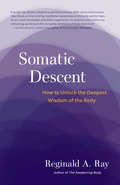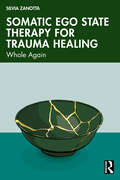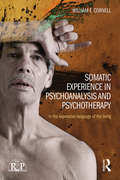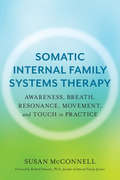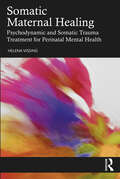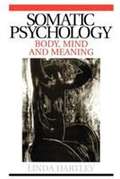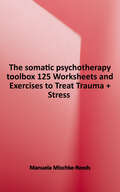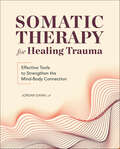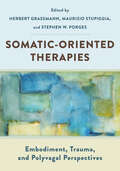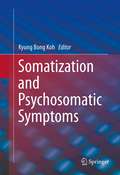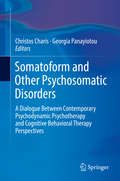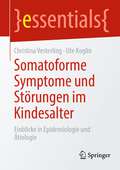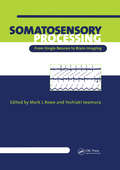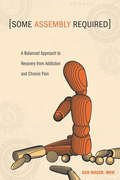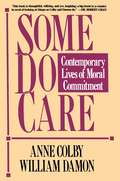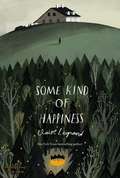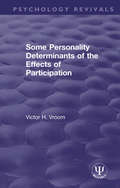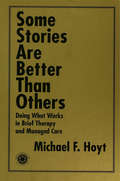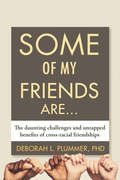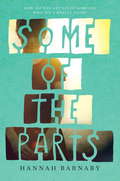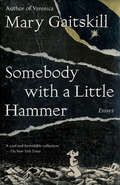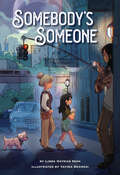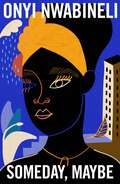- Table View
- List View
Somatic Descent: How to Unlock the Deepest Wisdom of the Body
by Reginald A. RayA powerful meditation practice for connecting with your body's innate, guiding wisdom.Have you ever had a "gut feeling" about a certain person or situation? Or a sense of intuition about how to respond to a particular challenge in your life? There's nothing magical or mystical about those kinds of scenarios. In fact, our body contains immense wisdom not directly available to our conscious mind, and it is continually communicating to us in the form of bodily feelings, impressions, sensations, corporeal intuitions, and felt senses. However, because most of us are so cut off from our somatic experience, we are quite unaware of this dimension of our body's expression. Although this intelligence may feel hidden most of the time, the wisdom of the body can actually be a guide for us in living our lives fully and also in responding compassionately to others. Through a meditation practice called Somatic Descent, Reggie Ray shows us how to connect with our body's intuitive intelligence. In Somatic Descent we see that the body is always showing us what sort of response, direction, or action may be called for at any given time, and can in fact be relied upon as a primary practical resource for decision-making in our everyday life.The book will include links to online audio recordings of the guided meditations to further aid the reader.
Somatic Ego State Therapy for Trauma Healing: Whole Again
by Silvia ZanottaThis book integrates Ego State Therapy with body-based therapies to present a multidimensional approach to working with clients who have experienced trauma.Drawing upon a range of important modalities, including Somatic Experiencing®, Polyvagal theory, Hypnotherapy, and Ego state therapy, Silvia Zanotta lays out a practical view of what it means to navigate the internal and external world in the aftermath of trauma. She provides an up-to-date applications-oriented view that prepares the practitioner to move beyond a one-size fits all treatment formula to meet the complexity of human experience. This approach holds that issues such as resistance, guilt and shame, rejection, and rage should be anticipated as a part of, more than an obstacle to, PTSD treatment. Case vignettes, transcript content, and step-by-step instructions for specific interventions and activities take the content of the chapters from theory to practice. This is a practical, experiential book that will appeal to all professionals working with trauma, including psychotherapists, counsellors, body workers, and social workers.
Somatic Experience in Psychoanalysis and Psychotherapy: In the expressive language of the living (Relational Perspectives Book Series)
by William F CornellThe body, of both the patient and the analyst, is increasingly a focus of attention in contemporary psychoanalytic theory and practice, especially from a relational perspective. There is a renewed regard for the understanding of embodied experience and sexuality as essential to human vitality. However, most of the existing literature has been written by analysts with no formal training in body-centered work. In this book William Cornell draws on his experience as a body-centered psychotherapist to offer an informed blend of the two traditions, to allow psychoanalysts a deep understanding, in psychoanalytic language, of how to work with the body as an ally. The primary focus of Somatic Experience in Psychoanalysis and Psychotherapy situates systematic attention to somatic experience and direct body-level intervention in the practice of psychoanalysis and psychotherapy. It provides a close reading of the work of Wilhelm Reich, repositioning his work within a contemporary psychoanalytic frame and re-presents Winnicott’s work with a particular emphasis on the somatic foundations of his theories. William Cornell includes vivid and detailed case vignettes including accounts of his own bodily experience to fully illustrate a range of somatic attention and intervention that include verbal description of sensate experience, exploratory movement and direct physical contact. Drawing on relevant theory and significant clinical material, Somatic Experience in Psychoanalysis and Psychotherapy will allow psychoanalysts an understanding of how to work with the body in their clinical practice. It will bring a fresh perspective on psychoanalytic thinking to body-centred psychotherapy where somatic experience is seen as an ally to psychic and interpersonal growth. This book will be essential reading for psychoanalysts, psychodynamically oriented psychotherapists, transactional analysts, body-centred psychotherapists, Gestalt therapists, counsellors and students. William Cornell maintains an independent private practice of psychotherapy and consultation in Pittsburgh, PA. He has devoted 40 years to the study and integration of psychoanalysis, neo-Reichian body therapy and transactional analysis. He is a Training and Supervising Transactional Analyst and has established an international reputation for his teaching and consultation.
Somatic Internal Family Systems Therapy: Awareness, Breath, Resonance, Movement and Touch in Practice
by Susan McConnellApplying somatic principles to the Internal Family Systems modelA Practitioner's Guide to Somatic IFS introduces a new therapeutic modality that blends principles of somatic therapy--like movement, touch, and breathwork--with the traditional tools of the Internal Family Systems framework. Broadening the benefits and applications of the IFS model, author Susan McConnell introduces 5 core practices that mental health professionals can apply to their practice: somatic awareness, conscious breathing, radical resonance, mindful movement, and attuned touch. Clinical applications include the treatment of depression, trauma, anxiety, eating disorders, chronic illness, and attachment disorders. Within the IFS framework, clients will learn to identify their "inner worlds"--the discrete subpersonalities within each of us that hold emotions, perceptions, and belief systems, and that affect our behavior and emotional wellness. Body-based somatic tools are incorporated into therapy as patients learn to recognize different facets of their internal family and reconcile the needs of subpersonalities--like their inner child or internal manager--to bring more harmony to their physical and emotional well-being.
Somatic Maternal Healing: Psychodynamic and Somatic Trauma Treatment for Perinatal Mental Health
by Helena VissingSomatic Maternal Healing introduces a cutting-edge understanding of the body into the growing field of perinatal mental health. Chapters lay out a complete trauma treatment model for maternal mental health, integrating psychodynamic and somatic clinical techniques within a systemic perspective. The book applies a biopsychosocial conceptualization of mental health in the perinatal period with a special emphasis on trauma and somatic trauma treatment. Somatic Maternal Healing is for anyone working clinically with mothers and new families, specifically therapists, clinical social workers, psychologists, psychoanalysts, psychiatrists, researchers, academics, clinical educators, and graduate students and trainees within these fields.
Somatic Methods for Affect Regulation: A Clinician’s Guide to Healing Traumatized Youth
by Kimberley L. ShilsonSomatic Methods for Affect Regulation is a unique resource that presents a variety of approaches for working somatically with youth. Chapters provide an overview of the relevant neuroscience research with a specific focus on affect regulation. The somatic techniques showcased in the book are evidence-based and illustrated with case studies showing their impact. Importantly, the chapters are also chock full of practical information, including strategies for working with dysregulated youth, information for collaborative and cooperative care, and an appendix with checklists and worksheets to help clinicians plan, guide, and assess their work.
Somatic Psychology: Body, Mind and Meaning
by Linda HartleyThis book brings attention to the interface of psychotherapy and psychological theory with the somatic practices of bodywork and movement therapy. To offer a client only psychotherapy, or only bodywork may subtly or directly reinforce the body-mind split from which so many of us suffer; in some cases this will be a reinforcement of a dilemma central to the client's problems. Hartley views body psychotherapy and transpersonal psychotherapy as building bridges between the once separated processes of psyche, soma, and spirit. Today the emerging field of somatic psychology is also contributing to the expanded field of psychology a subtle differentiation of bodymind process, developed through almost a century and a half of research and practice in somatic therapy and education. Originally trained as a dancer, movement therapist and bodywork practitioner, Hartley continues to use movement and somatic process as an important foundation for her own work. Training in Dance Movement Therapy, the transpersonal psychotherapy of Psychosynthesis, and Process-Oriented Psychology have further deepened Hartley's awareness of the relationships between psyche, soma and spirit, and the need to respond to all levels of experience in therapeutic work.
Somatic Psychotherapy Toolbox: 125 Worksheets and Exercises to Treat Trauma and Stress
by Manuela Mischke-ReedsFrom over 25 years of clinical experience, the author has created the go-to resource for mental health therapists who want to incorporate somatic techniques into their daily practice. Highly effective for clients dealing with trauma and stress disorders, somatic psychotherapy is the future of healing the entire person's body and mind. Section-by-section, this toolbox guides the clinician through: - Targeted somatic interventions for trauma, stress and PTSD - Steps to incorporate the body into your current therapeutic approach - Mindfulness techniques and breath work - Starting guidelines, safety concerns and keys to success- Getting to know their own body to better use body work with clients.
Somatic Therapy for Healing Trauma: Effective Tools to Strengthen the Mind-Body Connection
by Jordan DannThis insightful workbook introduces you to somatic therapy, an approach that helps release emotional and physical stress that is trapped in the body, so you can process your trauma and begin to heal.Heal from trauma and find inner calm using somatic therapy. Trauma lives on in both the mind and the body, and focusing on the body-mind connection is a powerful tool for healing. Somatic Therapy for Healing Trauma provides:Evidence-based techniques—Learn what somatic therapy is, how it works, and the key methods.Somatic therapy in practice—Use writing prompts, bodywork, and breathing exercises to regulate the nervous system and bring the mind and body into balance.A sense of calmness—Discover how somatic therapy can help you feel calmer, happier, and more anchored.Release the effects of trauma from your body and mind with somatic therapy by reading this mental health workbook!
Somatic-Oriented Therapies: Embodiment, Trauma, and Polyvagal Perspectives
by Stephen W. Porges Herbert Grassmann Maurizio StupiggiaAn innovative collection of research and theory from leading voices in the fields of trauma and somatic therapies. Somatic-Oriented Therapies represents a significant consolidation of innovative research and clinical approaches aimed at addressing trauma through various somatic modalities. In the past six decades, a multitude of therapeutic methods have emerged globally, revolutionizing trauma treatment and existential distress management. However, these approaches have often diverged, hindering the development of a cohesive, distinct field independent of traditional paradigms. This volume of collected work from some of the world’s leading experts in trauma aims to delineate this novel domain of research and clinical intervention. It elucidates the common thread linking the contributing authors and introduces a new clinical perspective. Central to this perspective is the recognition of the profound significance of the body-to-body relationship between therapist and patient; the critical role of trust establishment within the clinical context as a prerequisite for deep transformation; and the possibility to “question” the body, finding “unthought-of” avenues of transformation. Contributors include: Michael Allison, Martina Ardizzi, Ken Benau, David Berceli, Sue Carter, Cristiano Crescentini, Francesca Ferroni, Aaron Freedman, Vittorio Gallese, Jeltje Gordon-Lennox, Susan Harper, Molly Boeder Harris, Bach Ho, Steve Hoskinson, Hanneke Kalisvaart, J. David Knottnerus, Jacek Kolacz, Aline La Pierre, Rabih Lahoud, Francois Le Doze, Chairaa Marazzi, Alessio Matiz, Emily Newcomer, Pat Ogden, Antonia Pfeiffer, Betsy Polatin, Alessandra Pollazzon, Robert Schleip, Arielle Schwartz, Raja Selvam, Jane Shaw, Marlysa Sullivan, Jennifer Tantia, Chantal Traub, Donnalea Van Vleet Goelz, Ruby Jo Walker, Jan Winhall, Zabie Yamasaki, and Silvia Zanotta.
Somatization and Psychosomatic Symptoms
by Kyung Bong KohThis book, with contributions emanating from the 21st World Congress of Psychosomatic Medicine held in Seoul in August 2011, presents the latest evidence-based information about the mechanisms, assessment, and management of psychosomatic disorders from a biopsychosociocultural perspective. Somatization is a process characterized by excessive or inappropriate focus on physical symptoms that are medically unexplained. It is highly prevalent in primary care medicine, as somatoform (psychosomatic) disorders tend to be chronic and can cause significant personal suffering and social problems as well as financial burden.
Somatoform and Other Psychosomatic Disorders: A Dialogue Between Contemporary Psychodynamic Psychotherapy and Cognitive Behavioral Therapy Perspectives
by Christos Charis Georgia PanayiotouThis intriguing volume presents the most contemporary views on the conceptualization and treatment of somatoform disorders and related conditions from experts in psychodynamic and cognitive behavioral approaches. It does so with respect to both perspectives, without advocating for either approach. By presenting expert views from diverse perspectives, the book raises, what is a central point in most of the chapters, that emotion, its processing and regulation, is a cornerstone of these disorders. The volume also highlights the role of pathogenic coping or defense mechanisms like dysfunctional avoidance (from a CBT perspective) and conversion (from the psychodynamic perspective) in the maintenance of psychosomatic symptoms. The volume’s contents include detailed literature reviews on the most common—and most treatment-resistant—mind/body conditions, including chronic pain, responses to trauma, alexithymia, and the spectrum of health anxiety disorders. Noted experts distinguish between types of medically unexplained symptoms, discuss their complex processes, and provide models for intervention where cognitive-behavioral or psychodynamic approaches may be appropriate or effective. And a fascinating case study of a patient presenting multiple trauma-related disorders explores therapist resourcefulness over a course of shifting symptoms and frustrating setbacks. Among the topics covered: Maintaining mechanisms of health anxiety: current state of knowledge.Negative affect and medically unexplained symptoms.Alexithymia as a core trait in psychosomatic and other psychological disorders.Trauma and its consequences for body and mind.Embodied memories, a new pathway to the unconcious.Psychotherapy among HIV patients: a look at a psychoimmunological research study after 20 years.Health anxiety: a cognitive-behavioral framework. The wealth of options discussed in Somatoform and Psychosomatic Disorders offers health psychologists, psychiatrists, psychotherapists, counselors, and psychoanalysts bold new ideas for case formulation, treatment planning, and intervention with some of their most intractable cases.
Somatoforme Symptome und Störungen im Kindesalter: Einblicke in Epidemiologie und Ätiologie (essentials)
by Ute Koglin Christina VesterlingDieses essential thematisiert somatoforme Symptome und Störungen im Kindesalter. Änderungen der Störungsklassifikationen werden betrachtet. Entwicklungsrelevante Risikofaktoren und deren Zusammenwirken werden in einem heuristischen Modell dargestellt. Praxisimplikationen für Behandler*innen der medizinischen und psychotherapeutischen Praxis werden aus dem Modell abgeleitet.
Somatosensory Processing: From Single Neuron to Brain Imaging
by Mark Rowe Yoshiaki IwamuraThe diversity of contemporary investigative approaches included in this volume provides an exciting account of our current understanding of brain mechanisms responsible for sensory and perceptual experience in the areas of touch, kinesthesia, and pain.Postgraduate research students in sensory physiology, neurology, psychology and anatomy, and r
Some Assembly Required
by Dan MagerAn intriguing story that addresses the twin challenges of addiction and chronic pain and presents a model for successful recovery from both of these serious, life-altering conditions. The author grounds his story in psychological theory along with the principles of twelve-step philosophy and spirituality as he moves from intellectualized awareness to a deep emotional and mindful practices connection in recovery.Dan Mager, MSW, is a writer and editor in long-term recovery.
Some Choice: Law, Medicine, and the Market
by George J. AnnasThe authors goal is to help open a deep and democratic dialogue on health and human rights that trancends slogans and chants, and can lead to local, national, and international cooperation to define, protect, and promote both health and human rights.
Some Do Care
by William Damon Anne ColbyA look at the lives of twenty-three American moral leaders shows how these hometown heroes acquired their moral goals and sustained them in the face of grave risk and sacrifice, working for everything from civil rights to the poor.
Some Kind of Happiness
by Claire LegrandReality and fantasy collide in this “beautiful and reflective tale” (Booklist, starred review) for fans of Counting by 7s and Bridge to Terabithia, about a girl who must save a magical make-believe world in order to save herself.Things Finley Hart doesn’t want to talk about: -Her parents, who are having problems. (But they pretend like they’re not.) -Being sent to her grandparents’ house for the summer. -Never having met said grandparents. -Her blue days—when life feels overwhelming, and it’s hard to keep her head up. (This happens a lot.) Finley’s only retreat is the Everwood, a forest kingdom that exists in the pages of her notebook. Until she discovers the endless woods behind her grandparents’ house and realizes the Everwood is real—and holds more mysteries than she’d ever imagined, including a family of pirates that she isn’t allowed to talk to, trees covered in ash, and a strange old wizard living in a house made of bones. With the help of her cousins, Finley sets out on a mission to save the dying Everwood and uncover its secrets. But as the mysteries pile up and the frightening sadness inside her grows, Finley realizes that if she wants to save the Everwood, she’ll first have to save herself.
Some Personality Determinants of the Effects of Participation (Psychology Revivals)
by Victor H. VroomOriginally published in 1960, this study was carried out as part of the research of the Organizational Behavior and Human Relations Program of the Institute of Social Research. The primary purpose was to determine the effects of participation in decision-making on people with different personality characteristics. It was hypothesized that equalitarians and individuals with strong independence needs would be more positively affected by the opportunity to participate in making decisions than authoritarians and people with weaker independence needs. The results, based on data derived in an actual industrial setting, confirmed the hypothesis. The theoretical implications of the findings are discussed.
Some Stories are Better than Others: Doing What Works in Brief Therapy and Managed Care
by Michael F. HoytThere are stories that we use to explain what happened to us twenty years ago or last wee, those we use to explain why the world works the way it does, and those that we sue to "fix" the world when it doesn't work the way other stories said it should. And as the author points out in this collection of essays and interviews, some of these stories are better than others. This book is an investigation into which might be the better stories and how they can help clients reach their goals in therapy. This book contains fifteen essays and interviews written or co-written by Michael Hoyt. The collection represents Dr. Hoyt's recent thinking on helping clients with the brief, future-orientated therapeutic approaches.
Some of My Friends Are...: The Daunting Challenges and Untapped Benefits of Cross-Racial Friendships
by Deborah PlummerAn insightful look at how cross-racial friendships work and fail within American society.In a U.S. national survey conducted for this book, 70% of respondents strongly agreed that friendships across racial lines are essential to making progress toward improving race relations. However, further polling found that most Americans tend to gravitate towards friendships within their own racial category.Psychologist, Deborah L. Plummer tells us why that is so. She examines how factors such as leisure, politics, humor, faith, social media, and education influence the nature and intensity of cross-racial friendships. With engaging stories and inspiring anecdotes drawn from national focus groups, interviews, and analyses of survey results of contemporary patterns of adult friendships, she provides insights into the fears and discomforts associated with cross-racial friendships. Through these narratives and social analyses of friendship patterns, Plummer explores how we make connections to form solid bonds, and why it is so challenging to do so across a racial divide. She discusses how we cross that divide and get beyond the prickly uncomfortable moments and have meaningful, enlightening, empathetic conversations about race. With the inclusion of personal stories, this book stirs up authentic racial discourse, prompts readers to examine their own friendship patterns, and encourages us all to create a better path toward a more enlightened future by crossing racial lines in friendship and deepening the strength of current cross-racial friends.
Some of the Parts
by Hannah BarnabyFor fans of Love Letters to the Dead and I'll Give You the Sun comes a heartrending story of a teen who sets out on an unusual quest. For months, Tallie McGovern has been coping with the death of her older brother the only way she knows how: by smiling bravely and pretending that she's okay. She's managed to fool her friends, her parents, and her teachers, yet she can't even say his name out loud: "N--" is as far as she can go. Then Tallie comes across a letter in the mail, and it only takes two words to crack the careful façade she's built up: ORGAN DONOR. Two words that had apparently been checked off on her brother's driver's license; two words that her parents knew about--and never revealed to her. All at once, everything Tallie thought she understood about her brother's death feels like a lie. And although a part of her knows he's gone forever, another part of her wonders if finding the letter might be a sign. That if she can just track down the people on the other end of those two words, it might somehow bring him back. Hannah Barnaby's deeply moving novel asks questions there are no easy answers to as it follows a family struggling to pick up the pieces, and a girl determined to find the brother she wasn't ready to let go of.
Somebody with a Little Hammer: Essays
by Mary GaitskillFrom one of the most singular presences in American fiction comes a searingly intelligent book of essays on matters literary, social, cultural, and personal. Whether she’s writing about date rape or political adultery or writers from John Updike to Gillian Flynn, Mary Gaitskill reads her subjects deftly and aphoristically and moves beyond them to locate the deep currents of longing, ambition, perversity, and loneliness in the American unconscious. She shows us the transcendentalism of the Talking Heads, the melancholy of Björk, the playfulness of artist Laurel Nakadate. She celebrates the clownish grandiosity and the poetry of Norman Mailer’s long career and maps the sociosexual cataclysm embodied by porn star Linda Lovelace. And in the deceptively titled “Lost Cat,” she explores how the most intimate relationships may be warped by power and race. Witty, tender, beautiful, and unsettling, Somebody with a Little Hammer displays the same heat-seeking, revelatory understanding for which we value Gaitskill’s fiction.
Somebody's Someone
by Linda Oatman HighTwelve-year-old Ruby Bean has become an Accidental Expert on Missing Mothers. When her mother, Ruthie, goes missing again due to mental illness and addiction, Ruby and her aunt leap into action to search for Ruthie. A jewelry store robbery and unexpected kindness from the victim bring more twists to the journey. From Georgia to Washington to New York City, Ruby discovers that sometimes even the worst events can bring the best surprises into one's life, if you keep believing.
Someday, Maybe
by Onyi Nwabineli'An astonishing debut, rich in both heartbreak and humour' Jendella Benson, author of Hope & Glory Stunningly honest and bursting with wit, Someday Maybe is the story of grief and resilience that you won't be able to stop talking about Here are three things you should know about my husband: 1. He was the great love of my life despite his penchant for going incommunicado 2. He was, as far as I and everyone else could tell, perfectly happy. 3. On New Year&’s Eve, he killed himselfAnd here is one thing you should know about me: 1. I found him. Bonus fact: No. I am not okayEve is left heartbroken by her husband's unexpected death, but everyone around her – her friends, her boisterous British-Nigerian family, her toxic mother-in-law – seems to be pushing her to move on. Unable to face the future, Eve begins looking back, delving through the history of her marriage in an attempt to understand where it went wrong. So begins an unconventional love story about loss, resilience, and a heroine bursting with rage and unexpected joy.
